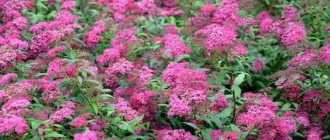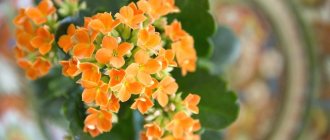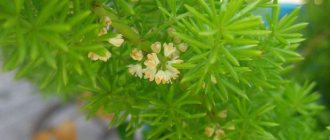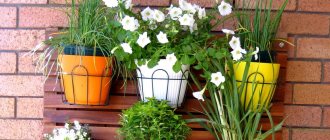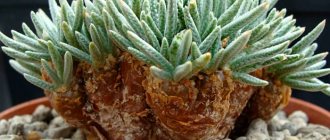Spiraea is a deciduous ornamental shrub of the Rosaceae family. Distribution area: steppes, forest-steppes, semi-deserts, mountain slopes, valleys. Landscape designers select varieties so that they bloom from early spring to late autumn. They place bushes singly and in groups, on garden paths, along fences, walls, and create borders, flower beds, rockeries, rock gardens.
Description of spirea
Spiraea (meadowsweet) - translated from ancient Greek means “bend”, has dwarf species up to 15 cm and tall ones up to 2.5 m. Its branches are erect, creeping, sometimes spread out, recumbent. Color – light chestnut, dark. The bark peels off longitudinally.
Leaf blades sit alternately on petioles, 3-5 lobed, oblong or rounded.
Inflorescences are paniculate, spike-shaped, pyramidal, corymbose. Located throughout the stem, in the upper part - at the ends of the branches. The palette of flowers is snow-white, cream, crimson, pink.
The root system is represented by adventitious roots and is shallow.
Alpenglüchen
Tiny snow-white flowers grow on a spherical bush. Alpenglüchen has spreading branches and narrow leaves of a grassy green color.
Spiraea: Japanese, gray, vangutta and other types and varieties
There are about a hundred species of spirea, they are divided into spring-flowering - they bloom in early spring on the shoots of the previous season in the second year after planting, the color is mostly white. They are also distinguished by the formation of many aboveground branches.
Summer-flowering ones form inflorescences at the ends of young shoots, while last year's ones gradually dry out.
Spring-flowering
When spring spireas bloom, they cover the leaves and branches with flowers.
| View | Description | Leaves | Flowers |
| Wangutta | Bushy, spreading, spherical up to 2 m, with drooping shoots. | Smooth, small, jagged, dark green, gray underneath, turning yellow in autumn. | White, honey-bearing, blooming from umbrella inflorescences. |
| Varieties | Bloom | ||
| Pink Ice. | May, August. | ||
| oak leaf | Frost-resistant shrub up to 1.5 m, branches pubescent. The crown is lush, rounded, and reproduces by roots. | Oblong, with teeth, dark green. The bottom is gray and yellow in autumn, up to 4.5 cm long. | Small, white, 20 pcs. in inflorescence. |
| Nippon | A low bush in the shape of a ball up to 1 m, the branches are brown, horizontal. | Round, bright green up to 4.5 cm, do not change color until mid-autumn. | The buds are purple and bloom white with a yellow-green tint. |
| Varieties | Bloom | ||
| May June. | ||
| Gorodchataya | Up to a meter high, the crown is loose. Tolerates low temperatures, drought, partial shade. | Gray-green, obovate with veins. | White, cream-colored flowers are collected in corymbose inflorescences. |
| Gray | Fast growing up to 2 m, with branched curved branches. Shoots are tomentose, pubescent. | Gray-green, pointed. | White, terry. |
| Varieties | Bloom | ||
| Grefsteim. | May. | ||
| Arguta | Spreading up to 2 m, branches thin, curved. | Dark green, narrow, jagged, up to 4 cm long. | Snow-white, fragrant. |
| Thunberg | Reaches 1.5 m, dense branches, openwork crown. | Thin, narrow. Green in summer, yellow in spring and orange in autumn. | Lush, white. |
| Varieties | Bloom | ||
| Fujino Pink. | Mid-May. | ||
Summer flowering
Summer ones form paniculate or cone-shaped inflorescences.
| View | Description | Leaves | Flowers |
| Japanese | Slow-growing, up to 50 cm, with erect, free stems, young shoots are pubescent. | Elongated, ovoid, veined, serrated. Green, gray underneath. | White, pink, red, formed at the tops of shoots. |
| Varieties | Bloom | ||
| June-July or July-August. | ||
| Willow | Up to 1.5-2 m, vertical, smooth branches. Juveniles are yellow and light green, turning reddish-brown with age. | Pointed up to 10 cm, jagged along the edges. | White, pink. |
| Douglas | Grows up to 2 m. Red-brown, erect, pubescent shoots. | Silvery-green, lanceolate with dark veins. | Dark pink. |
| Boumalda | Up to 75 cm, erect branches, spherical crown. | Obovate, green in the shade, in the sun: golden, copper, orange. | Pink, raspberry. |
| Varieties | Bloom | ||
| June August. | ||
| Billard | Up to 2 m high, frost-resistant. | Wide, lanceolate. | Hot pink. |
| Varieties | Bloom | ||
| Triumph. | July-October. | ||
| White-flowered | Dwarf, 60 cm - 1.5 m. | Large, green with a red tint, yellow in autumn. | Fluffy, white. |
| Varieties | Bloom | ||
| Macrophila. | July August. | ||
| Birch-leaved | Bush up to a meter, spherical crown. | Ellipse-shaped, light green up to 5 cm, turning yellow in autumn. | They bloom white with pink hues from 3-4 years of age. |
Species diversity
Spiraea is often found in landscape design. Several species are involved in landscaping a personal plot. They are suitable for forming a single composition and go well with trees and low-growing flowers.
Gray
Gray spirea is used in landscape design to create hedges, borders and compositions. A two-meter plant that blooms profusely in spring. Felt, ribbed branches with white flowers take up a lot of space and can replace a hedge. It begins to bloom in the last month of spring, and after 25-35 days it bears fruit. The plant cannot be propagated because it is a hybrid type. Below in the photo is Gray Spiraea in landscape design.
Wangutta
The photo shows Spirea Vangutta in landscape design . An adult shrub reaches up to 2.5 meters in height. It begins to bloom in late spring and does not lose its snow-white flowers until the end of the first month of summer. Suitable for forming mono-compositions and hedges.
Important! Grows well in both sun and partial shade.
shrub in landscape design . Not afraid of temperature changes, resistant to frost and drought. Does not require special care. It is distinguished by repeated irregular flowering in August. Grows quickly and propagates well by cuttings.
oak leaf
Spring flowering plant, reaches up to two meters in height. It grows in its natural environment on rocky slopes and mountain forests. This Spirea in the garden looks original. Flowering lasts three weeks and the weight of the branches bends towards the ground, forming a cascade of flowers. Amenable to shaping and cutting, the bush is not afraid of temperature changes, pests and illnesses.
Thunberg
The ornamental shrub Spiraea Thunberga is the grace of Japan and China in the garden. The bushes are covered with small white flowers. In autumn, the leaves turn orange, turning the bush into the main decoration of the garden. More demanding of care than other varieties. It grows better and blooms profusely in sunny areas. It does not tolerate cold, so shelter is required for the winter. Among other species it blooms earlier than all others.
Gorodchataya
In its natural environment, Spiraea Crenate is found on rocky mountain slopes, meadows and steppes. The shrubs grow up to a meter, bloom profusely and produce fruit early. Among gardeners, the species is considered valuable, as it is found in protected areas. On the reverse side of the leaf there are three characteristic veins. It blooms in early June, the flowers will begin to fall after 20-25 days. Despite its short stature, it is suitable for strengthening slumped soil.
A separate variety of Spiraea “Golden Princess” in landscape design is used in group compositions, borders, and single plantings. It has a persistent aroma, white flowers with a yellow center.
Features of planting spirea
Rainy and cloudy September weather is the optimal time for planting spirea. For cultivation, select an area with breathable, loose soil containing humus.
It is advisable to choose a place with access to the sun. Soil composition: leaf or turf soil, sand, peat (2:1:1). The planting hole is dug 2/3 larger than the seedling ball and left for two days. Place drainage on the bottom, for example from broken bricks. The roots are treated with Heteroauxin. Place the plant at 0.5 m. The root collar is left at soil level.
Planting in spring
In spring, it is possible to plant only summer-flowering plants before the leaves bloom. Select specimens that are flexible and have good buds. Dried roots are soaked in water, and overgrown roots are shortened. They lower the seedling, straighten the root, cover it with earth, and compact it. Water using 10-20 liters of water. A 7 cm layer of peat is placed around it.
Planting in autumn
In the autumn, summer and spring species of spirea are planted before the leaves fall. Pour soil into the center of the planting hole, forming a mound. The seedling is placed, the roots are leveled, covered and watered.
Features of cultivation
It’s easy to grow a representative of the variety in your garden plot. The main thing is to study the characteristics and provide care. It is worth deciding on the species in advance, choosing strong and healthy seedlings. They are selected based on the characteristics of the site, type of soil and geographical location. For the northern regions it is better to select frost-resistant varieties, and for the South any type of shrub is suitable.
Deadlines
Spirea is planted in spring and autumn before the leaves fall. If you plant it later, the bush will not have time to take root and gain strength before the onset of frost. Gardeners recommend planting in cloudy weather. You should not choose a dry period, as there is a risk of reducing the survival rate of the bush.
Soil preparation
Despite the unpretentiousness of the variety, the soil for planting is prepared. Peat and sand are added so that the soil becomes loose and breathable. Universal garden soil is suitable, which is poured into the planting hole. The more abundantly fertilized the soil, the faster the shrub will take root.
Planting schemes
A hole with dimensions of 30 by 30 cm should be up to 70 cm deep. A distance of up to a meter is maintained between the holes. If you plan to make a hedge from the bushes, then the distance between the holes is reduced to 30 cm. Then the algorithm is followed:
- Pour drainage into the bottom of the hole. Crushed stone, broken brick or large pebbles will do.
- Pour the first layer. Sand or special substrate up to 5 cm.
- Plant a seedling. Carefully place the plant on a “mound” of substrate. The roots can be straightened.
- Bury the seedling to the level of the root collar. They compact the earth.
Two buckets of water are poured under the bush; it is permissible to cover it with eggshells to prevent pest attacks. You can mulch the soil around the seedling with pine needles, peat, or finely chopped bark. The photo shows Spirea in landscape design.
Care
After the first spring pruning, a fertilizer with a high nitrogen content is applied. Potassium and phosphorus are added in the summer, and organic feeding is repeated in the fall. If you neglect the latter, then the risk of dying after the first frost increases. An adult bush is watered twice a month, pouring out 10 to 20 liters of water, depending on the growth and type of plant.
Important! Old branches are pruned any day, regardless of the growing season.
Once or twice a season, the ground around the bush is loosened. Be sure to weed and leave holes so that air can pass more easily to the roots. The plant does not require shelter for the winter. It is enough to insulate the soil around with humus or a dense layer of foliage.
Reproduction
Spiraea is propagated by layering, cuttings and seeds. Hybrid varieties are rarely propagated. Features of each method:
- By layering. A young shoot of a three-year-old bush is used. Break off and scrape off the bark, dig into a shallow furrow and secure, water generously. In the spring you can transplant it to a permanent place.
- Cuttings. A strong annual shoot is cut, the foliage is torn off and placed in a solution to accelerate the formation of roots for 8-12 hours. The cuttings are planted in a box with fertile soil and transplanted to a permanent place in the spring.
- Seeds. Seeds are collected from the fruits and planted in early autumn after the last frost.
The latter method is considered less reliable. Plants rarely take on the qualities of their parents. They have weakened immunity and are more sensitive to soil and temperature changes. They bloom less often and not as profusely as the parent plant.
Spirea care
Caring for the shrubs is not difficult; water them regularly, using 1.5 buckets for each, 2 times a month. They loosen the ground and remove weeds.
They are fed with nitrogen and mineral mixtures in the spring, with minerals in June and with phosphorus-potassium in mid-August.
Spiraea is disease resistant. Spider mites may appear among pests in dry weather. The leaves have white spots on top, turn yellow and dry out. Treatment is carried out with acaricides (Acrex, Dinobuton).
Bitten off inflorescences indicate an aphid invasion; an infusion of garlic or Pirimor helps.
Insects: Variegated leaf miner and rose leaf miner cause leaves to curl and dry out. They use Etafos, Actellik.
To prevent the appearance of snails, treat spirea with Fitosporin and Fitoverm until the leaves appear.
Appearance and botanical description
Nature has created about a hundred varieties of this plant. There are dwarf shrubs that do not grow higher than 20 cm. There are also tall specimens that can exceed the 2-meter mark.
All are united by a fibrous root system, which is located close to the exit to the surface. Small flowers collected in voluminous inflorescences give the culture a luxurious appearance. They are densely and densely placed on each branch, thereby creating a chic natural ensemble.
Flowering plant
The color of the bushes depends on the period of their flowering. Summer varieties shimmer in shades from soft pink to deep red. In spring, the branches are covered with snow-white living cover. And autumn species of spirea delight the eye with noble purple colors.
If you plant several varieties of spirea with different flowering times, you will be able to admire their exquisite beauty most of the year.
The season also affects the appearance of the inflorescences. These can be umbrellas, shields, brushes or complex panicles. The leaves grow in regular order, the colors vary from yellowish to rich green. There are usually 5 petals in a flower.
Most of all, the types of spirea differ from each other in their branches. They can be straight, recumbent, spread out to the sides or tending upward. The brown shade varies from light to dark, the bark exfoliates.
Mr. Summer Resident advises: pruning spirea
Without timely pruning, spirea looks unkempt; dry and weak branches prevent the formation of new shoots. To give the bush a decorative appearance, it is regularly pruned. Thanks to this, the plant forms powerful shoots and many inflorescences, allows more light and air to pass through, and reduces the risk of attack by pests and diseases.
In early spring, before the buds open, sanitary pruning is carried out. Frozen, diseased, thin, broken, dried branches are cut out from spirea. After flowering ends, spring varieties are immediately pruned and dry inflorescences are removed. New shoots with bright green leaves are removed from Japanese spirea.
For early bloomers, older than 3-4 years, stimulating pruning is carried out and in the fall they are cut to a quarter of the length. The plant can be given any shape desired (ball, square, triangle).
It is recommended to feed with mineral mixtures after the procedure.
Summer flowering plants need stimulating pruning from 3-4 years of age. Remove weak, diseased, old branches to the neck level with sharp pruning shears in the fall, half a month before frost, leaving 2-3 buds.
For spirea older than 7 years, anti-aging pruning is also carried out 2-3 weeks before frost. All branches are cut to the soil level, leaving 30 cm. In spring, the bush forms young shoots.
Popular varieties
is popular in landscape design due to its abundant flowering and versatility. “Snow-white hats” look great in group compositions and single plantings. It is permissible to plant it on the shore of a pond to strengthen the soil. General characteristics:
- resistant to temperature changes;
- does not require shelter for the winter;
- has arched drooping branches;
- white flowers are collected in bunches.
The hybrid was obtained by crossing whitish-gray and St. John's leaf varieties. Stands out among plants of another variety. The photo shows Spiraea gray Grefsheim in landscape design.
The Anthony Waterer variety is no less common. A unique hybrid of a white-flowered plant with bright red, purple flowers. Flowering lasts up to three months. Often used to form mono compositions. Decorates personal plots, squares and parks. The plant does not require specialized care and has good survival rate.
The photo shows Spiraea "Shirobana" in landscape design . A low-growing original shrub suitable for decorating ensembles and alpine slides. It blooms for up to two months; flowers of white, red and pink colors are located on one bush. The Snowound variety is a tall plant with a dense crown. Features of the variety:
- blooms no more than three weeks;
- branches fall under the weight of snow-white flowers, forming arches;
- does not tolerate drought;
- prone to the appearance of spider mites, requires preventive treatment.
Pale pink flowers are found in the Sparkling Champagne variety. This Japanese summer flowering plant with bright green foliage will be a worthy addition to the garden. Blooms profusely, not picky about soil. It is not afraid of frost, but cannot withstand prolonged drought. The shrub requires regular watering and loosening of the soil.
The original Spiraea "Goldflame" bushes in landscape design are used to decorate borders. An unpretentious and attractive plant up to 80 cm high has reddish-orange and yellow leaves. The buds have a distinct crimson hue. Below is a photo of Spirea “Goldflame” in landscape design .
Reproduction of spirea
To propagate by seeds, they are sown in prepared containers with wet sand and peat and sprinkled. They emerge after 1.5 weeks, are treated with Fundazol, and after 2-3 months they are transplanted into a specially designated bed in partial shade, while shortening the roots. Water generously. Flowering is expected only for 3-4 years.
Layering is a more common method of propagation. In the spring, before the leaves appear, the lower shoots are bent to the ground, fixed with a rod, wire, and sprinkled. Water regularly.
Replant the next year after the root system is fully formed.
In autumn, cuttings cut at an oblique angle of 15-20 cm are soaked for 12 hours in Epin, then treated with Kornevin and rooted in damp sand. After 3 months, roots form in more than half, the cuttings are covered with film, sprayed, ventilated and provided with diffused light. With the onset of spring, they are transplanted into open ground.
A bush dug out in September, which is 3-4 years old, is placed in a container with water, then divided into parts with 2-3 shoots and roots, and trimmed. Treat with fungicide and plant as usual.
Application in landscape design
Spiraea will be a wonderful decoration for both a small garden plot and the local area of a luxurious mansion. It can be used alone and for compositions, hedges or borders. The variety of varieties allows you to bring to life any, even very bold ideas.
If the bush is frequently pruned, it will not bloom profusely, but will decorate the landscape with original leaves.
Spirea borders
To decorate borders, it is better to use dwarf varieties of spirea. The main thing is that the planting height is no more than 40 cm, and the distance between the bushes is 50–70 cm. With this planting, the border will not interfere with other plants.
You may be interested in reading about diseases and pests of spirea.
Varieties suitable for forming borders:
- Golden Princesse;
- Little Princesse;
- Bullata;
- Shirobana;
- Crispa.
Tapeworm plants
They are designed to create a bright accent on the site. Various shrubs or trees are used as tapeworms. They do not require any additional design, and their bright appearance can independently add originality to the lawn or garden.
Also learn about the types of spirea that bloom pink.
The following varieties of spirea are suitable for soloing:
- Arguta;
- Gray;
- Wangutta;
- Nippon;
- plum-leaved;
- Douglas.
When using them in single plantings, the bushes should be pruned in a timely manner. Varieties with spring flowering are pruned immediately after it stops (last year's branches). In summer-flowering species, this procedure can be carried out both in the autumn and in early spring before the start of sap flow. Those that bloom in late autumn are pruned exclusively in early spring.
Don't forget about anti-aging trimmings. Spiraea grows quickly, so it is necessary to periodically remove old branches to give the plant strength.
Important! In the first year after planting, flowering will be minimal. Don’t be upset; with proper care, next year the shrub will delight you with full-fledged flowers, according to the variety.
Hedge
A living fence made from spirea will be an excellent choice - it is not expensive, not troublesome and beautiful. Thanks to the wide variety of varieties, you can grow hedges of different shapes. With combined planting (planting varieties with different flowering periods), the fence will delight you with a luxurious appearance all summer and autumn.
In order for the hedge to grow in an even row, before planting it is necessary to drive in stakes and stretch wire or twine at a height of 20–30 cm from the ground. The holes should be at least 50 cm deep, the distance between them should be 50–60 cm; if the planting is multi-row, an interval of 50 cm is also maintained.
Suitable varieties:
- Medium meadowsweet;
- Boumalda;
- Frobeli;
- Nipponica Snowmound;
- Arguta;
- Densiflora;
- Wangutta;
- Grefsheim.
In the flowerbeds
You can plant a flower bed or flower garden with a combination of different flowers and shrubs. The composition should be created taking into account the flowering period, so that the planting will smell fragrant all season long. Tall plants (lupine, weigela, delphinium, daylily) are usually planted in the center, and low-growing flowers and bushes are planted along the edges. Japanese spirea is ideally suited for this purpose. With the right composition, the flowerbed will be visible from all sides.
Description and photo
The spirea plant is a deciduous shrub up to two meters high. The most common forms are weeping, erect, hemispherical, cascading and creeping. Depending on the variety and type, the plant has a different leaf plate, as well as different inflorescences. Spiraea flowers are small, but very numerous. The color of the petals varies from white to crimson. In some species, the inflorescences completely cover the entire bush, while in others they are located only on the upper or lower part of the shoots.
The plant is often used in landscaping for its attractive foliage, which in some species changes color throughout the season, and for its decorative flowers. The shrub is unpretentious in care, undemanding to climate and soil. Spiraea grows and develops quickly, but flowering is observed only 3 years after planting.
All types of this shrub are conventionally divided into two groups - spring-flowering and summer-flowering spirea.
Correct fit
Almost all representatives of the genus Spiraea are light-loving plants, but some varieties tolerate partial shade. The best time to plant this plant is September, but summer-flowering species can also be planted in the spring, and specimens with a closed root system can be planted throughout the warm season.
- The planting hole or trench (in the case of a hedge) is prepared in advance. Its dimensions should exceed the dimensions of the root system by at least one third. If the groundwater in the area is close to the surface, then a drainage layer must be placed at the bottom of the hole.
- Spiraea has no special requirements for soil; garden soil or a mixture of leaf and turf soil is perfect. Billard's spirea grows best on sandy substrates, while Japanese spirea prefers more fertile soils.
- Before planting, you need to inspect the roots of the seedling - if they are slightly dry, then you should put the plant in water for a while. Diseased and dead roots need to be removed.
- When planting, the roots of the seedling are straightened and carefully covered with substrate, without deepening the root collar.
The unique Douglas spirea
An interesting deciduous shrub that has a very beautiful appearance, due to which it is widely used in landscape design. This type of spirea begins to bloom from the age of 3, but after that it will grow and delight the eye with abundant flowering every year for 20 years. Douglas's spirea is propagated by both cuttings and seeds, but most often the first option is preferable.
Despite its overseas origin, today this type of spirea can be found in gardens, parks and public gardens in various regions of our country.
Exquisite Spiraea oakleaf
The long ribbed shoots of this type of spirea, combined with interesting green-gray foliage with denticles, distinguish it from all others. The shrub reaches a height of 2 meters, but during the growing season, under the weight of the inflorescences, the branches bend almost to the ground, and therefore from the outside it may appear to be a rounded bush. The first flowers bloom in early May, after which the spirea blooms for about 25-30 days, delighting the eyes of those around with its exquisite inflorescences.
It should be noted that Spiraea oakleaf grows especially well in rich soils and is very sensitive to watering, which should be regular. This variety is quite winter-hardy, and therefore this spirea can be grown in the northern latitudes of our country. When cultivating a plant, it is also recommended to mulch the tree trunk circle with peat, which allows it to retain moisture well and prevent the soil from becoming covered with a dry crust.
Spiraea japonica
The bright yellow color of this plant pleasantly pleases the eye, uplifting the mood of passers-by and turning even the most ordinary landscape into a unique and extremely beautiful one. Today, such shrubs can be found both in parks and in public gardens of many cities, and often ordinary owners of private houses also prefer to plant it in their own homes.
This type of plant is best suited for borders and tolerates cutting, including short haircuts.
It should be noted that Japanese spirea today is found throughout the northern hemisphere, since it is unpretentious to grow and care for.
